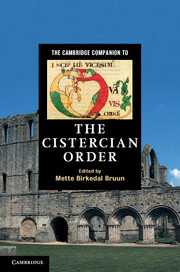Book contents
- Frontmatter
- Contents
- Figures
- Contributors
- Preface
- Abbreviations
- Introduction
- Part I History
- Part II Structure and materiality
- 4 Centres and peripheries
- 5 The Cistercian community
- 6 Constitutions and the General Chapter
- 7 Nuns
- 8 Agriculture and economies
- 9 Art
- 10 Libraries and scriptoria
- 11 Cistercian architecture or architecture of the Cistercians?
- Part III Religious mentality
- Map of Cistercian monasteries
- Primary sources
- Further reading
- Index
- References
5 - The Cistercian community
from Part II - Structure and materiality
Published online by Cambridge University Press: 05 December 2012
- Frontmatter
- Contents
- Figures
- Contributors
- Preface
- Abbreviations
- Introduction
- Part I History
- Part II Structure and materiality
- 4 Centres and peripheries
- 5 The Cistercian community
- 6 Constitutions and the General Chapter
- 7 Nuns
- 8 Agriculture and economies
- 9 Art
- 10 Libraries and scriptoria
- 11 Cistercian architecture or architecture of the Cistercians?
- Part III Religious mentality
- Map of Cistercian monasteries
- Primary sources
- Further reading
- Index
- References
Summary
According to tradition the New Monastery, later known as Cîteaux, was founded on 21 March 1098. The choice of day was no coincidence as on that day the feast of St Benedict was celebrated. It was also apt, for on moving from Molesme the twenty-one monks under their abbot Robert had left behind the ‘old’ ways of traditional monachism with its emphasis on the elaborate and time-consuming celebration of the Divine Office in order to embrace a ‘new’ interpretation of the Rule, one in which the balance between the three constituent parts of the monastic horarium – prayer, study and work – had been restored. The Rule and its revised implementation were basic to the Cistercian reform and were commented upon both in all early Cistercian texts as well as by a number of contemporary outside observers. The Premonstratensian abbot Philip of Harvengt claimed that with the foundation of Cîteaux the ‘monastic Order, formerly dead, was revived … and the Rule of St Benedict recovered in our times the truth of the letter’. Even some of the Cistercians’ severest critics acknowledged their achievement. The chronicler William of Malmesbury refers to their distress that they were not able to follow ‘the purity of the Rule’ to which he states that they attached great importance by saying, ‘So intent are they on their Rule, that they think not a jot or tittle of it should be disregarded.’ The Norman Benedictine Orderic Vitalis described them as endeavouring ‘to carry out a literal observance of the Rule of Saint Benedict’.
Although the Cistercians did away with many of the accretions to the liturgy that had been introduced over the centuries, the opus Dei – the Work of God – still remained their primary and distinctive occupation, constituting the very raison d’être of monasticism. St Benedict devoted twelve chapters in the Rule to its composition and the manner of celebrating the seven daytime canonical Hours of Lauds, Prime, Terce, Sext, None, Vespers and Compline, plus the Night Office. The primacy of the Office was endorsed by Bernard of Clairvaux in these words: ‘By our Rule we must put nothing before the Work of God.’
- Type
- Chapter
- Information
- The Cambridge Companion to the Cistercian Order , pp. 80 - 86Publisher: Cambridge University PressPrint publication year: 2012
References
- 2
- Cited by

